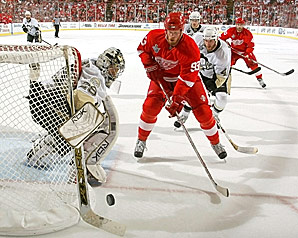
Red Wings have bright future
When he says, "Yes, of course! Who wouldn't, you fool?", ask him this:
"Well, why don't you?"
Try it. It's great fun, and you get to see if the human face can match the same shade of red as the championship sweaters of the above-named famously successful Detroit Red Wings.
The embarrassment comes from the fact that every one of those players was available to other GMs before the Red Wings drafted them. Some went around the draft wheel three, five, six, seven and even as many as 10 times.
Lidstrom, the captain, a five-time -- and by this time next week possibly a six-time -- Norris Trophy winner as well as the 2002 Conn Smythe playoff MVP, was selected in the third round of the 1989 entry draft. He was the 53rd player taken overall.
Franzen, the leading goal-scorer for much of Detroit's most recent playoff run, went in the third round in 2004, the 97th player taken overall.
Holmstrom, who has now had a role in four Cup championships in the last 12 years, went in the 10th round in '94, the 257th player taken.
Datsyuk, who has now won two Cups and the Lady Byng Trophy (gentlemanly play), and is a candidate for this season's Selke Trophy (best defensive forward) in addition to being one of the team's scoring leaders, was a sixth-round pick in '98, the 171st player taken overall.
Zetterberg, the MVP of the 2008 playoffs and the Red Wing who on Wednesday scored the Stanley Cup-clinching goal, is also one of the scoring leaders in both the regular- and postseason, and a candidate for the Selke this year. He was a seventh-rounder, taken with the 210th pick in 1999.
And on and on it goes.
This is the first time in recent history that the Red Wings have won a Cup without Scott Bowman as their coach and Steve Yzerman as their captain, but even as those two moved off to other roles in the organization, the team has stayed near the top. There's a commitment to excellence from owner Mike Illitch and general manager Ken Holland,and this franchise as well as future Red Wings teams stand to benefit from it.
"People expected us to go down," Illitch said after Detroit's fourth Cup since 1997 was secured. "The [salary] cap has changed things. Everyone wanted a level field, but we've been able to compete in the new system."
What makes the Detroit Red Wings great is not that they've remained an elite team for well over a decade. That's commendable on its own, but even more intriguing is that even though they are now one of the older teams in the NHL (average age: 32), it's not like this will be their last gasp at or near the top.
The Wings develop players better than most teams, and that's no accident. Detroit has perhaps the largest and most experienced hockey department in the game. They draft well, as shown above, and season their players with time and a system that makes certain the roster is deep for now as well as continually developing replacements for players who need to be replaced or supported en route to the time when they depart.
The Red Wings also manage their money very well. That's a tribute to Holland and associate GM Jim Nill. They have 10 of their core players -- Datsyuk, Zetterberg, Holmstrom, Franzen, Kris Draper, Mikael Samuelsson, Jiri Hudler, Kirk Maltby, Daniel Cleary and Tomas Kopecky -- signed through at least next season. That group represents just $21,475,000 of a salary cap that is expected to rise to somewhere in excess of $56 million for next season.
That's only on the front end.
On defense, Lidstrom, Brian Rafalski, Niklas Kronwall and Brett Lebda are also signed through next season. That's the core of the defensive squad that's on the ice every night, for about $17 million. The Wings are likely to let veteran Chris Chelios head into retirement. He's 46 and someone will have to give way in order to re-sign Brad Stuart and, perhaps, Andreas Lilja. Both are unrestricted free agents who have indicated their willingness to stay.
There's a bit of a question in goal, with Chris Osgood moving into the No. 1 spot. The Wings might want to look for a veteran to replace Dominik Hasek, who at 42 is likely headed toward yet another retirement. There is a young prospect in Jim Howard, but it's not a given that he's ready even for a backup slot.
What's amazing to most observers is that in addition to being a champion with a good deal of talent under contract and comfortably under the salary cap, the Wings have a lengthy list of prospects who are in various stages of a well-orchestrated grooming process as some of the older players are phased out.
Darren Helm, who had a contributing fourth-line role in the playoffs, is highly regarded as a center ice candidate, as are Justin Abdelkader and Jan Mursak on the left side. Villie Leino, recently signed as a free agent after a fast rise through the Finnish Elite League, is another forward who could well make an impact next season. Defensive prospects Kyle Quincey , a junior league All-Star before turning pro, and Jonathan Ericsson, an American Hockey League All-Star last season, are expected to contend for more ice time on the blueline next season.
That's not just luck. That's a program, a core group of players, a second group ready to challenge the core and a bevy of prospects in various levels of development.
No team is perfect, but the Red Wings appear perfectly positioned to stay at or near the top of the NHL for years to come. They are champions on the ice in no small part because of the championship quality of their organization off it.




